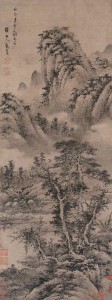吴浈: “在山里的雾”
这幅画显示了几座山,特别是山顶。有些是近的,有些是更远的,比较难看到。还有一些很大的雾围绕在周围的山脉,山上也有植物。在画的底部,有一棵大树。这是很难看到的,因为这幅画只有黑色,而是树的右侧是一个小房子,左边是一个渔夫在他的小船上。
吴浈是在中国元朝的一个艺术家(公元1271-1368年)。他使用了假名梅花道人。他是这一时期最著名的画家之一,他是元四大家之一,与黄公望,倪瓒,王蒙一起。他把元时期新的态度,与历代的一些保守的特质相结合起来。他的画特别抽象,除了大自然的化身之外,更注重环境要素的平衡。
很多人相信景观是中国画的最高形式。这种风格象征着人类的探索和加盟性质,和寻找他们的日常生活的混沌中的避难所- 政治和个人 的。由于有很多雾和简单的自然的特点在这幅画中,所以使它也有一个深刻的精神意思,表现出一个人与自然的和谐。雾似乎带来一种神秘感和平衡。画中几乎所有的自然元素之间都显示了平衡,因为它具有了空气,水和土。简单的渔夫的生活,也许象征着着谦卑与和平,和与人世的隔离。
Wu Zhen, “Mist in the Mountains”
The painting features several mountains, specifically the mountaintops. Some are nearby while others are farther away and harder to see. There is also a lot of mist surrounding the mountains as well as several plants and a large tree at the bottom of the painting. It is hard to see because the painting is done in black only, but to the right of the tree is a small house and to the left of the tree is a fisherman in his boat.
Wu Zhen was an artist during China’s Mongol Yuan Dynasty (1271-1368), and used the pseudonym Meihua Daoren (the Daoist of the plum blossom). One of the most famous painters of this period, he was one of the Four Masters of the Yuan, along with Huang Gongwang, Ni Zan, and Wang Meng. Paintings of this time period were a combination of the new attitudes of the Yuan period with some conservative qualities from previous dynasties. Wu Zhen’s paintings in particular are more abstract and focus on a balance of environmental elements as well as the personification of nature.
Many people believe landscape is the highest form of Chinese painting, at least traditionally and historically. This style symbolizes humans exploring and becoming one with nature, finding a sanctuary from chaos – political and personal – of their daily lives. Because of the mist and abundance of simple, natural features in this painting, there is a deep spiritual quality in this painting, showing a man’s harmony with nature. The mist seems to bring a sense of mystery as well as balance. The painting shows a balance between almost all of the natural elements because it features air, water, and earth. The simplicity of the fisherman’s life perhaps symbolizes humility and peace as well as isolation.

